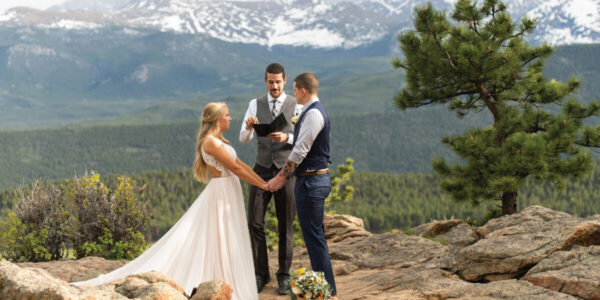
This Unsung California Town Has the West’s Best BBQ
In and around Santa Maria, CA, succulent oak-grilled barbecue is a way of life. So why isn’t it better known?
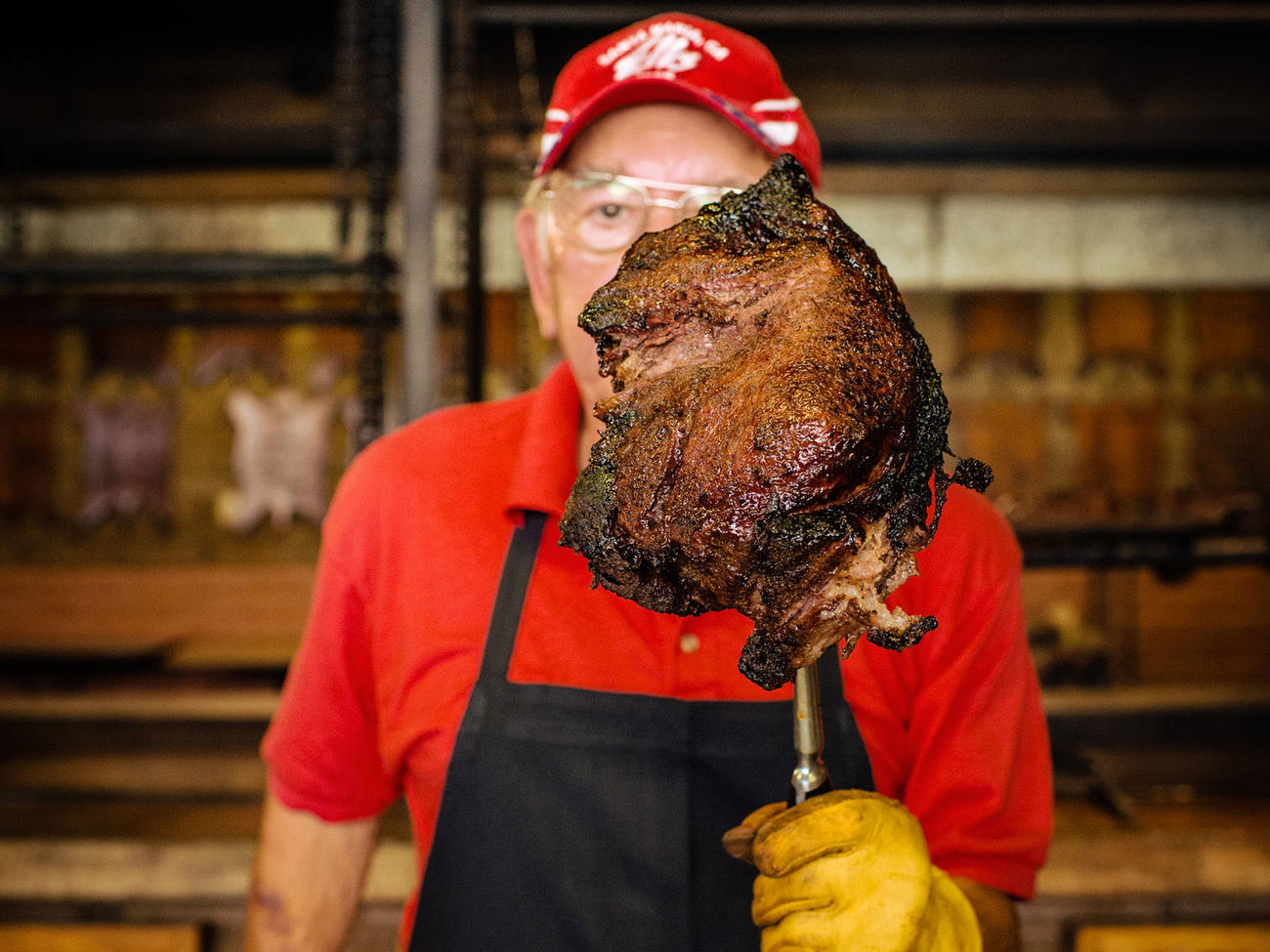
The scent of red oak hangs thick and spicy-sweet in the air like good pipe tobacco, seasoned with the traces of decades of barbecue. Even early in the morning, before the fires are lit, it fills this cavernous room at the Santa Maria Elks Lodge, flavoring every breath I take. At the back stands a massive pit, a brick rectangle about 20 feet long and waist-high. Soon, as it has so many times before, it will sizzle and drip with America’s least-known best barbecue.
“This is the true Santa Maria–style barbecue,” says Ike Simas, leader of the pit crew. He’s 86, impish and friendly, and has been barbecuing with the Elks for 60 years. His crew are six men in their 70s and 80s, with weathered faces and strong arms, in fire-engine-red shirts saying SANTA MARIA ELKS BAR-B-QUE TEAM on the back. They’re busily rolling hefty chunks of top sirloin—each about 6 pounds and aged for a month in the Lodge’s refrigerators—in a mix of salt, pepper, and garlic salt. The seasoned meat lies piled all over the table like spicy footballs. Within a few hours, it will be served to hundreds of people in the Lodge dining hall.
Barbecue has defined social life in and around the city of Santa Maria—which sprawls across a swath of ranchlands and vineyards between San Luis Obispo and Santa Barbara—for 150 years, probably more. Records from the days of the ranchos, the giant cattle ranches that covered this territory when it was Mexico, describe almost bacchanalian scenes of whole bulls’ heads and other beef cuts roasted in pits dug in the ground. Tortillas, salsa, and beans were served along with a slew of other sides. These were all-day celebrations—for vaqueros relaxing at the end of a cattle roundup, or guests from the city invited for a ranch adventure. By the early 1900s, a less daunting cooking style had emerged—asado, which involved skewering hunks of beef on green willow rods and setting them across a pit of burning red oak.

Remarkably, that’s still pretty much how people here do it: over a fire of California coastal red oak, which grows thickly along the Central Coast; and on a grill that raises and lowers the meat to the flame—asado, but improved. The meat has no sauce, just a dry rub of salt, pepper, and garlic salt, and is usually eaten with tiny, plump local beans called pinquitos. Garlic bread and pasta (either cold as macaroni salad or hot as mac ’n’ cheese) replaced tortillas somewhere along the way, as Swiss-Italian immigrants arrived to work on dairy farms—and the salsa lost its heat and acquired celery and Worcestershire sauce. Green salad came into the picture too.
A men’s club called the Santa Maria Club started serving this menu once a month, from 1931 until the group folded in the ’70s, and the Elks Lodge took it up too, in the ’30s. Over the years it’s become a kind of set piece, as hallowed and familiar as Thanksgiving turkey dinner. The menu is rooted so deeply, and stirs such pride in the area, that the Santa Maria Valley Chamber of Commerce copyrighted it in 1978.
Today, it could be the Fourth of July, or Labor Day, or Christmas; it could be a wedding or a church social or a birthday, or, when you come right down to it, an ordinary weekend; it could be in a restaurant or park or backyard. At any of these times, in any of these places, you’ll find people hanging out around a Santa Maria grill with their families and friends.
In the Elks barbecue room, the fires blaze up from the long pit. “I would say you’ve got about 200 years in barbecuing right here,” Simas says, gesturing at the crew. Who’s been at it the longest? I ask.
“I cut one of the first trees God made and barbecued with it,” says Jerry Lloyd.
Within two minutes they’re reminiscing about the epic catering jobs they’ve done.
“How ’bout that one at the Cow Palace, for 3,400, in 1976?”
“Or that one near Indio, when the wind kept blowing away the heat and getting sand in the meat?”
“I remember the police chiefs’ association at the L.A. Forum. We fed 5,000 in 48 minutes.”
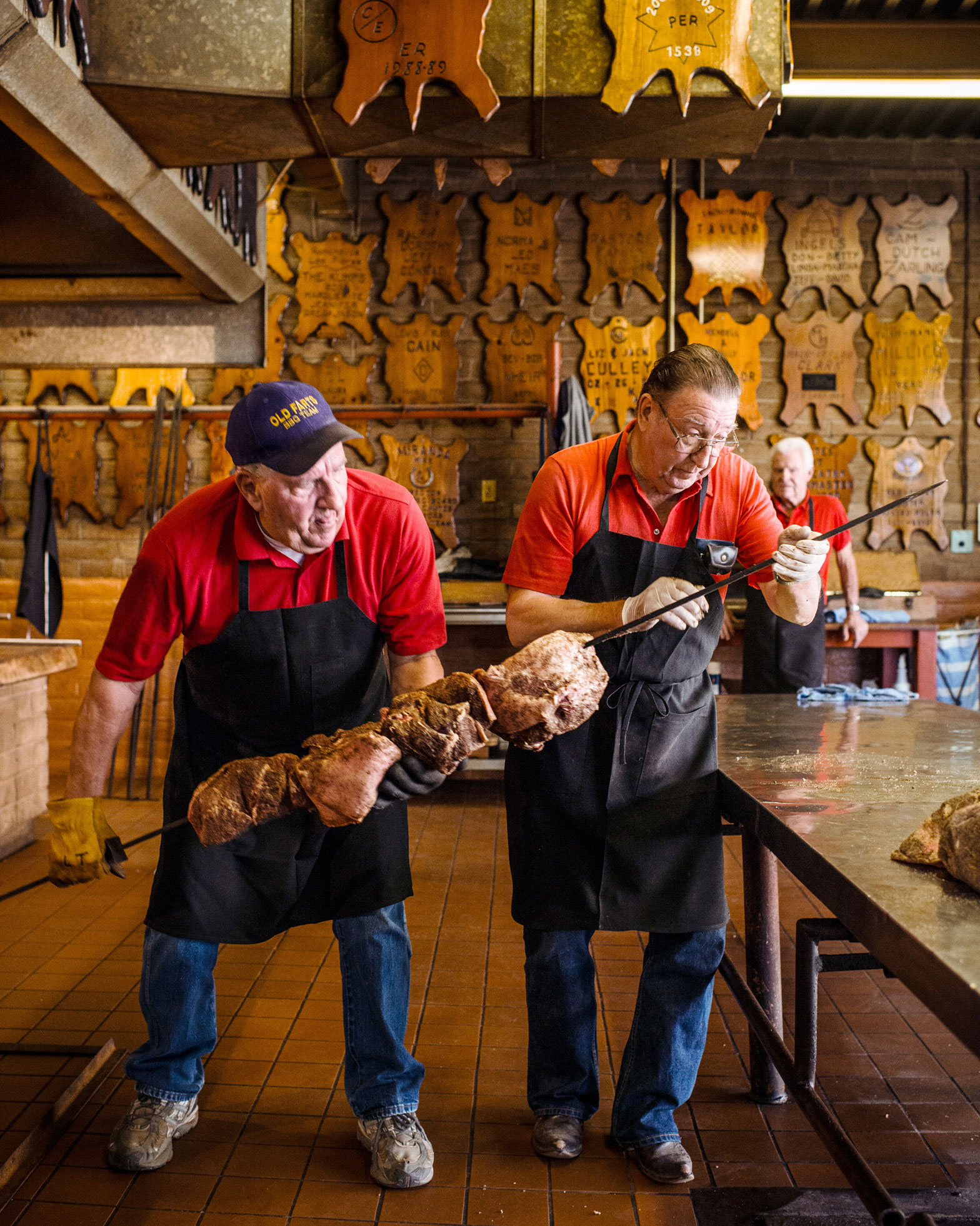
They are not kidding. Cooking over mobile pits on wheels, skewering the meat on rods like the asadors of long ago, the Elks barbecue for crowds at events all over the state and beyond. Other area caterers have done so too, most famously the Los Compadres crew from Santa Ynez, who went to the White House five times to cook for President Reagan. Mabel H. Brandon, the White House social secretary back then, wrote to thank them: “It has taken me two days to recover from your absolutely delicious barbecue and to find the appropriate words to thank you … for the best meal that has ever been served outdoors at the White House.”
Yet Santa Maria–style barbecue has never taken hold beyond the region, not even four hours away, in San Francisco. People here speculate that it’s because building a log fire might seem daunting, or that people expect sauce with barbecue, or that “barbecue” is thought of as meat smoked long and slow over indirect heat—the way it is in Kansas City or Memphis—instead of grilled.
Or maybe it seems like a job best left to the experts, at least when done Elks-style. The skewering of the sirloins looks like some kind of atavistic Olympic sport. I watch an elderly Elk brace a 6-foot rod against the table, bend a chunk of meat into the shape of a C, and cram it onto the wickedly sharp tip with both hands. He does this repeatedly, until the rod is full. He isn’t even breathing hard.
Soon 12 of these giant shish kebabs rest over the pit. The scent of roasting meat rises up from the fire. Back during the rancho days, the asador would slice little pieces off the meat as it cooked, for the ravenous children. I’m not a child, but I really wish I were, so I could ask.
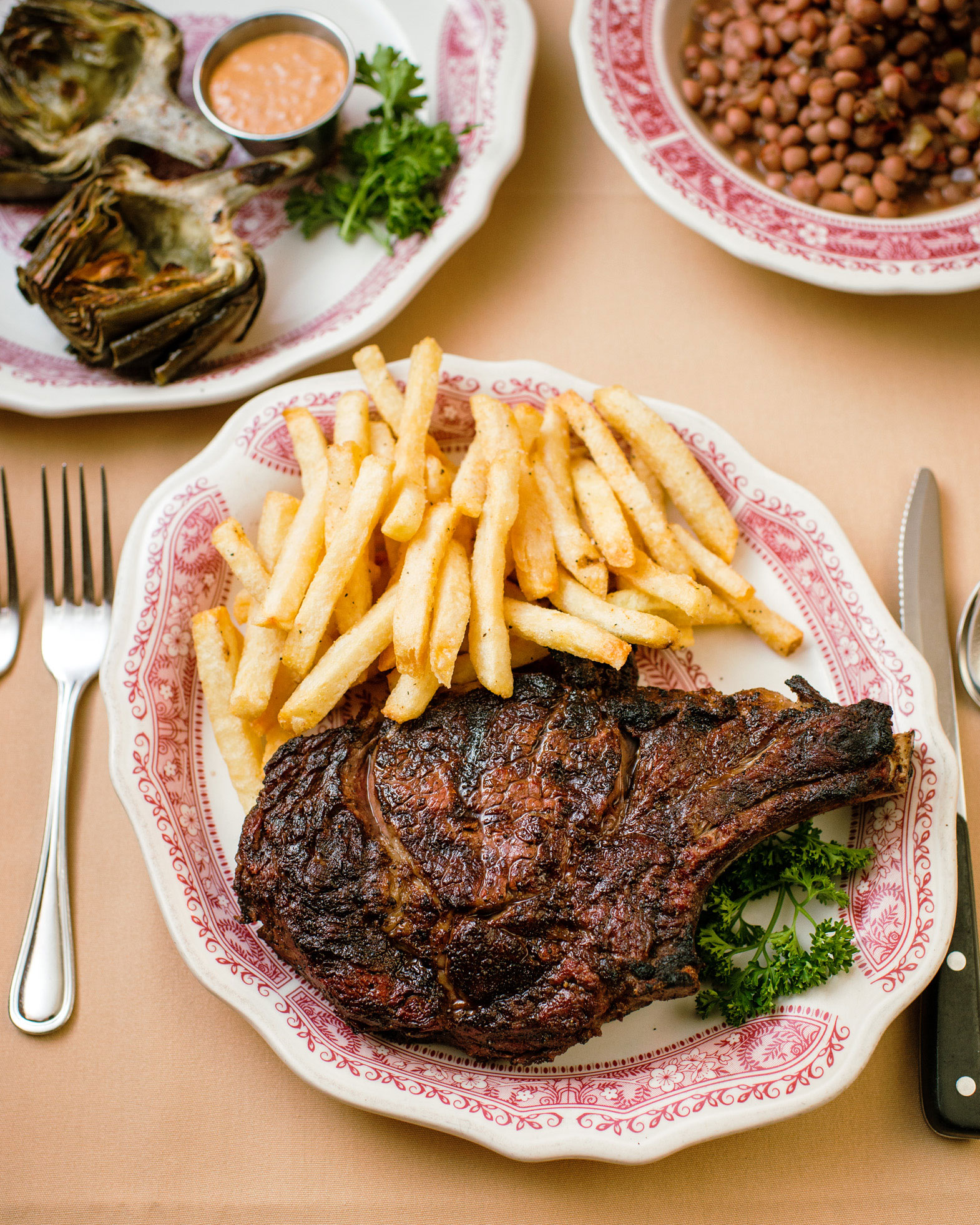
“Rib-eyes! That’s what we started out with,” Simas remembers, turning the meat. Grilled as thick, bone-in steaks, prime rib was the cut of choice in Santa Maria during the 1930s and 1940s. As rib-eye got to be too pricey, the Elks moved to top sirloin. Tri-tip, the cut most people associate with Santa Maria barbecue, came along only in the 1950s, when a local butcher decided to stop grinding it up for burgers and start selling it as a roast. But it will never be the star of an Elks barbecue. “Personally, I don’t like the flavor,” Simas says.
He’s not a fan of charcoal, either. “It leaves a little taste, like fast food.” What about gas? Simas just smiles, crosses his arms, and lets his silence answer. He cooks over red oak, period. And no sauce. “The reason they put all that goop on in other places is because they don’t have choice cuts of meat,” he says. “Our meat is good, and we like to taste it.” The Elks are the keepers of the flame, and they mean to pass on what they know. “We’re breaking in some younger guys right now,” Simas explains. “They’re in their 40s. We have older guys with them, of course. We don’t just turn ’em loose.”
Over the course of about two hours, the meat turns a glistening, rich brown. It’s time to serve. In the main kitchen, cooks are readying the beans, salads, and salsa. Moving fast now, the Elks toast up a bakery’s worth of split soft French loaves and dunk them in pans of melted garlic butter. They heave the rods off the fire one by one, push the hunks off in a meaty tumble, and slice them thick with curving knives that look like machetes.
The lodge manager bursts into the room. “I got 180 of ’em already lined up!” he yells, and runs out with a trolley of meat and bread. I trot right behind him into the dining hall.
It’s a vast room decorated with a mirror ball and set with what seems like an acre of tables covered in cheery green plaid. I settle into a seat with my plate from the buffet. The meat is still hot, stacked in rosy, tender slices, and so beefy and minerally that each bite sets up a craving for the next. With it are the velvety, bacon-studded pinquitos; cold, creamy macaroni salad; the almost indecently buttery garlic bread; and the mild salsa. “It’s always so good,” the man next to me says, sighing happily. “Mmmph,” agrees his neighbor, mouth full.
Santa Maria’s main drag, Broadway, used to be one long corridor of white smoke every Friday and Saturday. Fund-raising groups would set up Santa Maria grills and sell plates to passersby. “You could barely see to drive,” says Cindy Ransick, curator at the Santa Maria Valley Historical Society museum (where, incidentally, there’s a barbecue exhibit). Finally the streetside barbecue got too big. In 2009, the city imposed limits on frequency and hours, and the county came in with health regulations. Now just a few wisps of smoke go up on weekends.
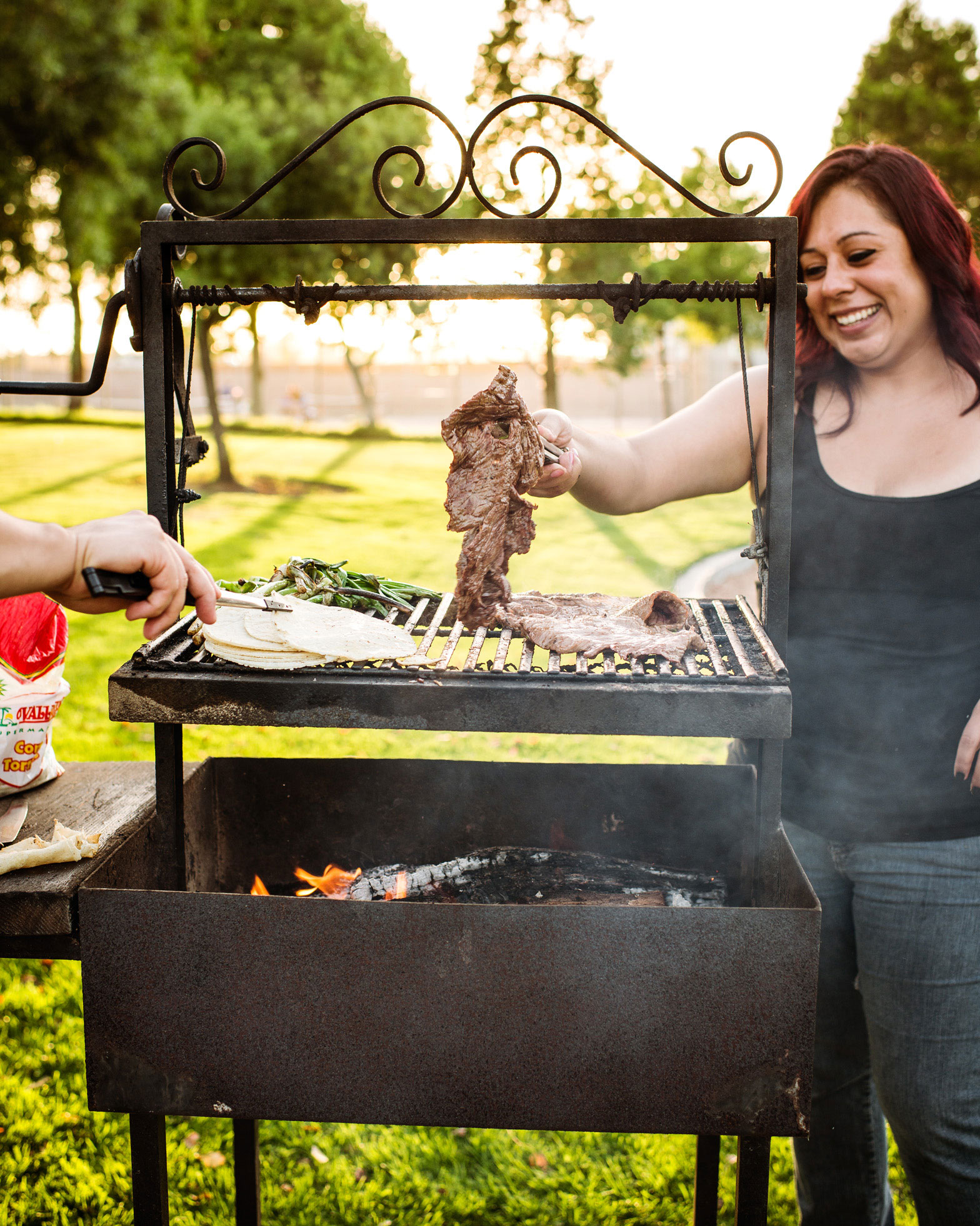
That hasn’t dimmed the local ardor for oak-grilled meat, though. The Far Western Tavern, started by two ranching families in 1958, moved from the remote little town of Guadalupe last fall to a new location off the 101 freeway just south of Santa Maria. Its business doubled. Other bastions of barbecue are likewise packed.
One of the toughest places to get into is Jocko’s, in Nipomo, 8 miles north of Santa Maria. “You go there to eat, you don’t go to swank,” Ike Simas’s son, Gary, told me. It hasn’t changed since it opened in 1962, a snug den presided over by Sandy Knotts, Ike’s niece, a tiny, buxom lady with chunky gold jewelry and a purr of a voice. By around 4, when the pit fires up, there’s a line out the door.
When I was there last, I walked out back to the pit and watched my Spencer steak—a center-cut boneless rib-eye—being cooked by Daniel Knotts, Sandy’s 26-year-old grandson. The meat was grilled not on rods but on a thick metal screen, the standard practice at restaurants and for home cooks. The fire was ferocious, stopping me several feet away. Daniel danced in and out of the wall of heat to flip the meat, holding one arm up against his body like a boxer. “It’s my insulation,” he explained, unconvincingly. It’s a wonder his hair didn’t ignite.
Like most places in Santa Maria barbecue country, Jocko’s follows the traditional seasoning mantra of salt, pepper, and garlic salt. The Hitching Post restaurants stand on tradition too, but embellish it a little. At the original Hitching Post in the way-out-in-the-country town of Casmalia and at the better-known Hitching Post II in Buellton, the basic blend adds white pepper, plus cayenne and onion powder, and the meat is basted with garlicky oil and vinegar.
“We think of Santa Maria barbecue as a flavor on its own,” says Frank Ostini, the exuberant owner of The Hitching Post II. At a glassed-in pit in the dining room, he grills all kinds of things over red oak: beef steaks and chops, but also quail, duck, pork, shrimp, lobster, and artichokes. “We wood-smoke red peppers and tomatoes and mix them with mayonnaise for our grilled artichokes,” he says. “We’ve wood-smoked hops for beer.”
I order the bone-in rib-eye because I can’t stop coveting the one at the neighboring table. It’s the biggest steak I’ve ever seen—at 26 ounces, practically architectural—and it is utterly luscious. To go with it, I choose Ostini’s own Highliner Pinot Noir, one of several wines he makes with partner Gray Hartley; they’re famous for their Pinots, especially after the restaurant appeared in the movie Sideways. “During all the hoopla, 20 to 50 cars a day would stop just to take a picture,” Ostini says. “But it was important to maintain who we were, so we’ve kept it all the same.”
It probably doesn’t matter how many times Santa Maria barbecue is served at the White House or shows up in a movie. It will never conquer San Francisco or Seattle. Red oak grows best here, and pinquito beans grow nowhere else. The grills are ingenious but, for some reason, mostly made locally. The food is so simple, so straightforward, that its deliciousness and depth of flavor depend on having exactly the right ingredients, wood and grill included, cooked by people who are grilling because it’s part of how and where they live. You can make a good approximation of Santa Maria barbecue outside the Central Coast, but for the real thing, you have to come here.
Joe Caicco, owner of Santa Maria Barbecue Outfitters, and his bubbly daughter, Vincenza, invite me to a barbecue up at their family retreat—they call it “the saloon”—in the foothills near Santa Maria. It’s built into the side of a canyon, and Joe, a man of seemingly limitless energy, overhauled a rustic shack to make it spacious and elegant, with porches all around. Not surprisingly, they have the Tesla of home grills outside, a 10-foot-long creation with an artful turning wheel.
It looks slightly intimidating, but Joe shows me how simple it is to cook on. Whenever the flames erupt, he cranks the screen loaded with tri-tips, ribs, and sausage up a couple of notches so nothing will scorch. “On a regular grill, you have to cover the food or it’ll burn,” he says. No fiddling with vents or indirect heat: This is easy, immediate control over fire.
Even before Joe manufactured grills, he built them on his own with his father, for fun, and they’d cook on them together for the family. “Barbecue is kind of bred into us,” says Vincenza. Pretty much every weekend, the Caiccos are up here, dancing, drinking beer, and eating barbecue. Vincenza was married on the slopes above, and you can guess what was on the wedding menu.
A few months later, while walking through a Santa Maria park, I stop and introduce myself to a family having a picnic, intrigued by the smells coming from their grill. Stephanie Correa, who’s cooking, explains that it’s carne asada—Mexican-style flap steak marinated in spices and orange juice. Their Santa Maria grill is unusually pretty, with a decorative swirl on the top bar. A stack of tortillas warms in a corner; beans sit on a table ready for spooning out, along with a toasted-chile salsa that her mother made. This barbecue doesn’t conform to the copyrighted Santa Maria menu, but it looks a little like lunch on a rancho long ago. “This is our form of hospitality,” says Correa. “It’s allowing people you don’t know to come into the family.” And she hands me a taco.
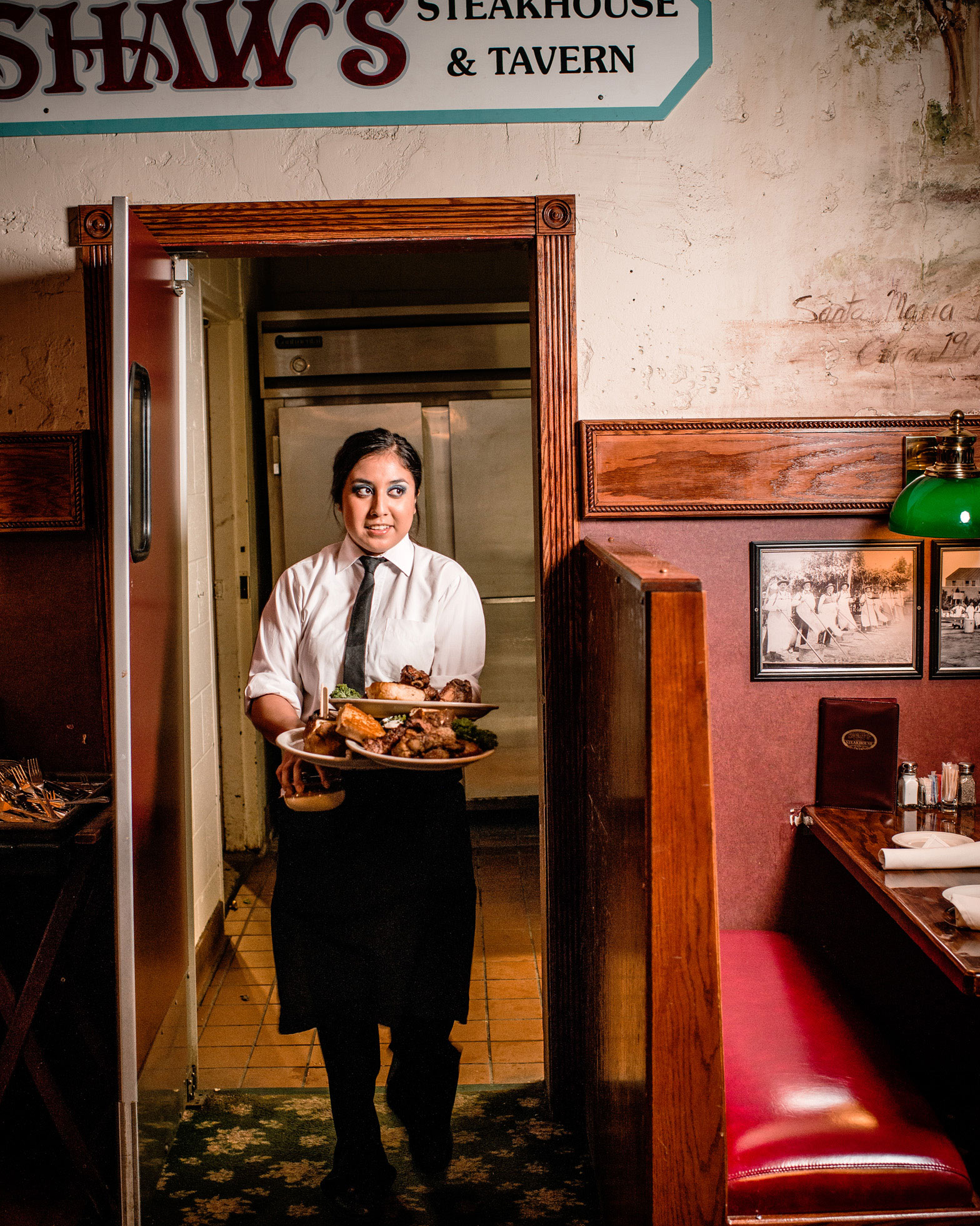
Where to Eat Barbecue in Santa Maria
Countless restaurants serve Santa Maria barbecue along California’s Central Coast. After three years of research—canvassing experts, visiting restaurants, and eating well north of 100 pounds of meat—our overstuffed food editor, Margo True, has proclaimed these the best.
Far Western Tavern (300 E. Clark Ave., Orcutt). In its spiffy new location off the 101 freeway, the Tavern serves up the same peerless barbecue it has for decades—plus sophisticated dishes like oak-grilled polenta and wild salmon salad. $$$$.
Jocko’s (125 N. Thompson Ave., Nipomo). The locals’ hangout, with terrific steaks and views of the oak pit from the dining room. There’s a big old bar too, with an over-the-top snack: chunks of grilled beef and garlic bread, with toothpicks and salsa. $$$.
Filipino Community Center food truck (1721 S. Broadway, Santa Maria). One of the few remaining fund-raising outfits on Santa Maria’s main street serves a delectable soy-marinated take on tri-tip. $.
The Hitching Post I (3325 Point Sal Rd., Casmalia) & The Hitching Post II (406 E. State 246, Buellton). Open since 1952, Hitching Post I is the oldest barbecue restaurant in the area, with a light-filled dining room. The food is simple and perfect. Hitching Post II, made world-famous by Sideways, has the classics and more—including grilled artichokes, a knockout chocolate tart, and a fine wine list, with many bottles under $30. $$$$.
Garey Store & Deli (3798 Foxen Canyon Rd., Santa Maria). Head to the town of Garey (pop. 68) on Santa Maria’s outskirts for this deli’s incredible tri-tip sandwich, Fridays only, from 10 to 2. A favorite with the vineyard workers, it’s just juicy, thin-sliced meat piled high on a French roll, with salsa and jalapeños on the side. Call ahead to get one saved for you—owner Shawn Rees makes only about 150 per Friday. $.
Shaw’s (714 S. Broadway, Santa Maria). A huge, old-timey elegant place, filled with shining wood, brass, and historic local barbecue photos. The whole range of Santa Maria barbecue tradition shows up here, from tri-tip to spicy oak-grilled linguiça sausage, a gift from the Portuguese who immigrated to the area in the ’30s and ’40s. $$$.
McPhee’s Grill (416 S. Main St., Templeton). Go at dinnertime, when the pit’s lit, for red oak–grilled artichokes and steaks. You can’t miss with the rib-eye, which comes with three homemade salsas as well as jalapeño-cheese mashed potatoes and roasted poblano chiles stuffed with goat cheese. $$$$.
Rancho Nipomo BBQ & Cal-Mex (108 Cuyama Lane, Nipomo). Bright and cheerful, with an inspired melding of Santa Maria barbecue and Mexican food. Meats are smoked—not grilled—over red oak, and used in inventions like a smoked tri-tip burrito and a tri-tip sandwich made with garlicky Mexican-style torta bread. $.
For more of our favorite Santa Maria BBQ spots, check out our handy map.
